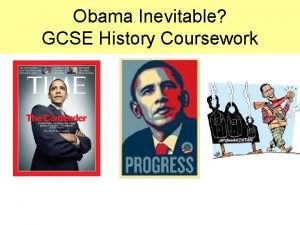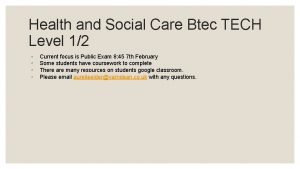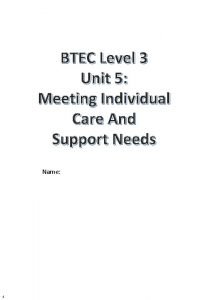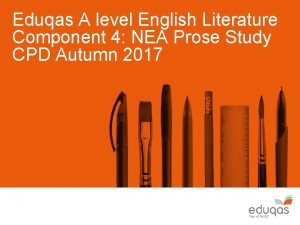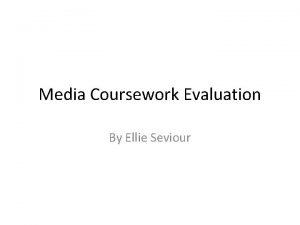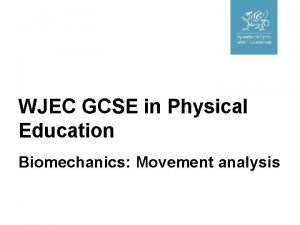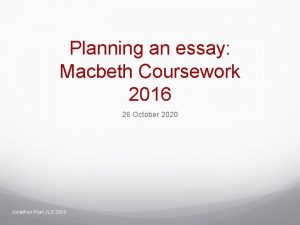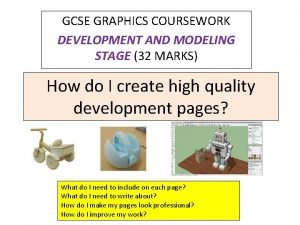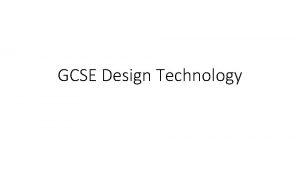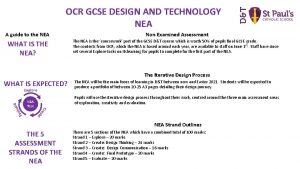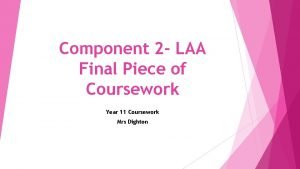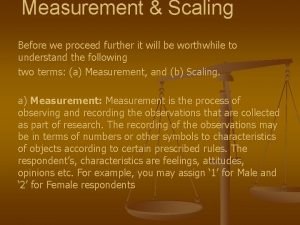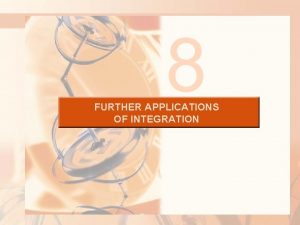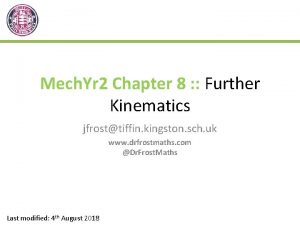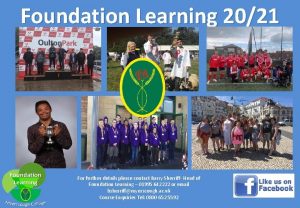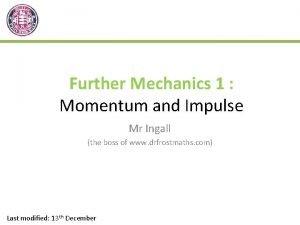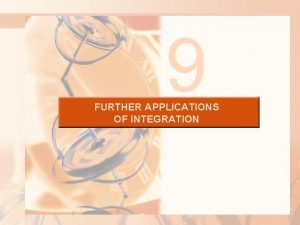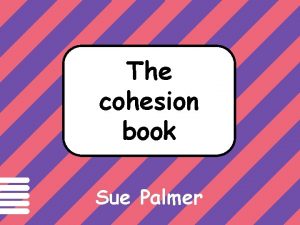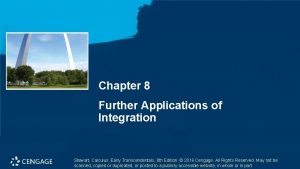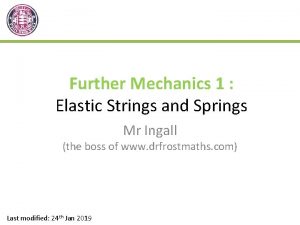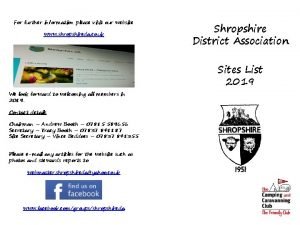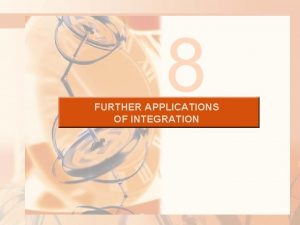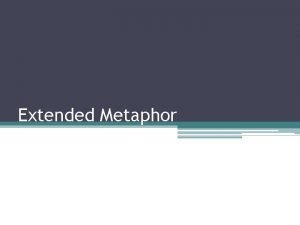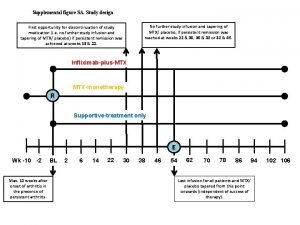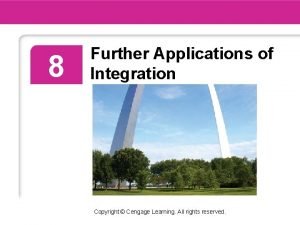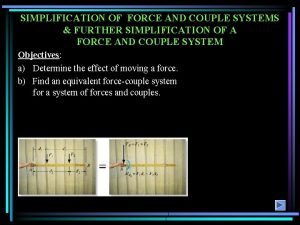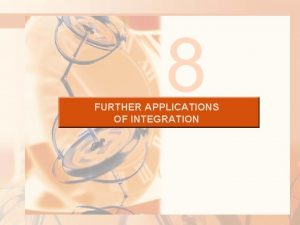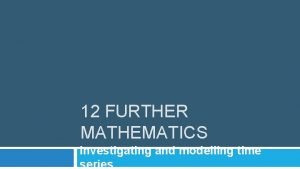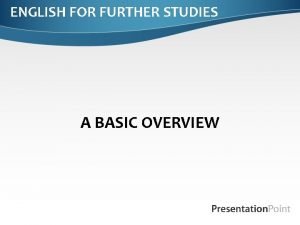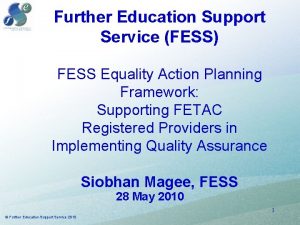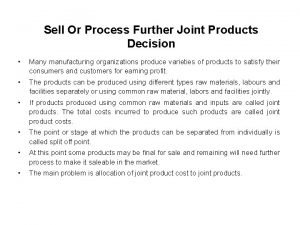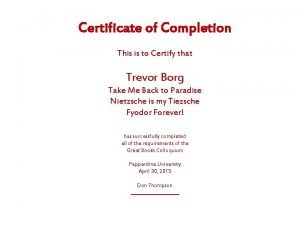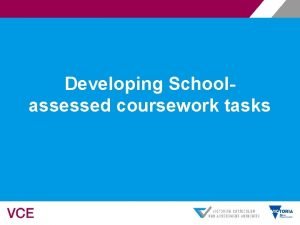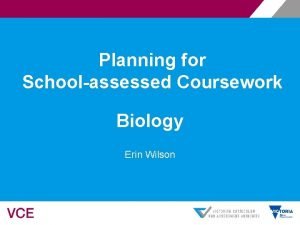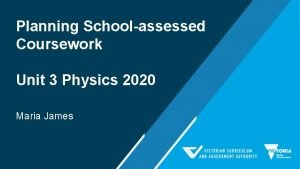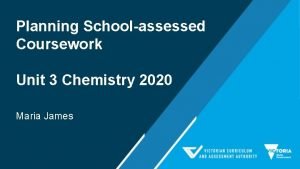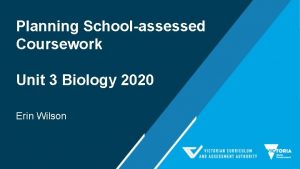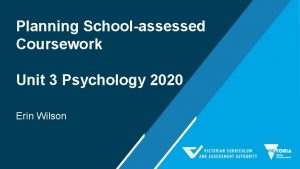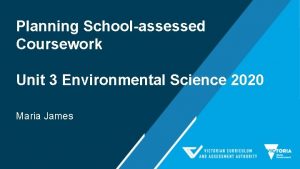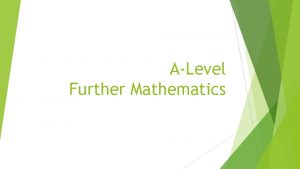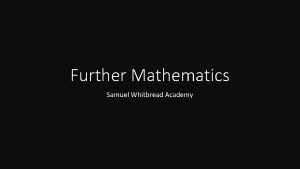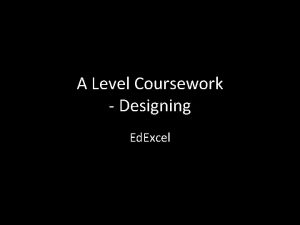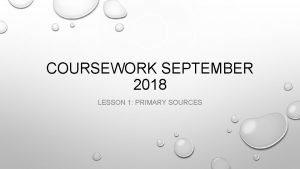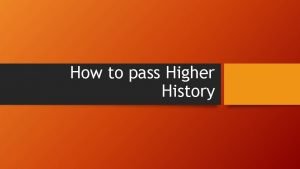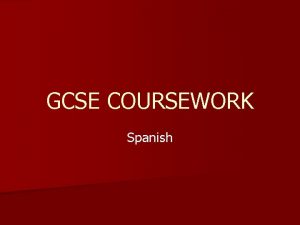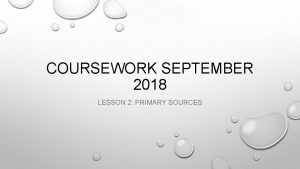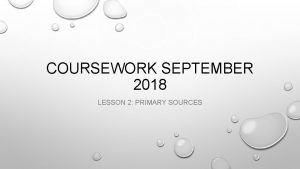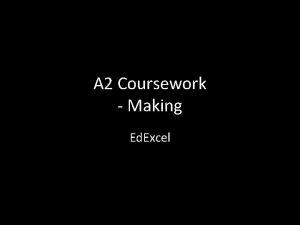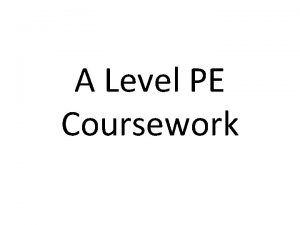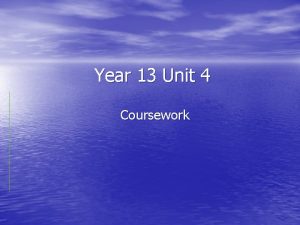VCE Further Mathematics Schoolassessed Coursework Copyright The copyright



































































- Slides: 67

VCE Further Mathematics School-assessed Coursework

Copyright The copyright in this Power. Point presentation is owned by the Victorian Curriculum and Assessment Authority or in the case of some materials, by third parties. No part may be reproduced by any process except in accordance with the provisions of the Copyright Act 1968 or with permission from the Copyright Officer at the Victorian Curriculum and Assessment Authority.

VCE assessment principles Assessment is an integral part of teaching and learning at the senior secondary level that: - identifies opportunities for further learning - describes student achievement - articulates and maintains standards - provides the basis for the award of a certificate.

VCE assessment principles As part of VCE studies, assessment tasks enable: - the demonstration of the achievement of an outcome or set of outcomes - judgment and reporting of a level of achievement for school-based assessments at Units 3 and 4.

VCE assessment principles VCE assessment will be: - valid equitable balanced efficient.

Validity School-assessed Coursework and examinations make distinct and complementary contributions to student assessment. School-assessed Coursework enhances validity of student assessment by providing the opportunity for a context, scenario or situation to be explored mathematically in greater breadth and/or depth than is possible in an examination, with non-routine and openended elements explored more fully.

VCE Mathematics assessment Two types of formal assessment: - School-based: prescribed task types, School-assessed coursework, locally devised and assessed - Examinations: externally set and marked. Both types of assessment are based on the outcomes in relation to the areas of study.

Timeframe for tasks The tasks for School-assessed Coursework for Mathematics are to be implemented over a longer continuous period, where investigative, modelling or problem-solving techniques or approaches are employed and the related use of technology as a tool for working mathematically is suitably incorporated.

Context for a task A practical context, scenario or situation is central to the development of School-assessed Coursework tasks in Further Mathematics. This context, scenario or situation is to be explored in some breadth and depth, with natural connection to stimulus items and questions of interest.

Content and task design A task for School-assessed Coursework will not cover all of the content from an area of study, module or topic, or all of the key knowledge and key skills for an outcome. The context, scenario or situation on which the task is based will afford connection to some of these more than others.

Further Mathematics Unit 3

Application task A guided investigation of a given data set with several variables. The task has three components of increasing complexity: - the construction, description and interpretation of data plots, including smoothed plots where time series data is used - the calculation and interpretation of summary statistics, including seasonal indices and their application where time series data is used - the modelling of linear associations, or trends where time series data is used, including the use of data transformation as appropriate. The application task is to be of 4 -6 hours duration over a period of 1 -2 weeks.

Statistical investigation Is the process of using population and sample data sets, constructs, structures and related techniques to represent, visualise and describe aspects of data from a real-world context in a simple and concise way to: investigate features and characteristics of data distributions; to model and compare them; to explore questions of interest and to make predictions related to the context. This includes the use of different data types; primary and secondary data; methods of obtaining data; sets, response and explanatory variables; constants and parameters; relations and functions; statistical graphs; tables, charts and diagrams; scatterplots; summary statistics; randomness; samples; equations; association and correlation; regression; data transformation; model fitting; times series and their features; deseasonalisation; trends; smoothing and prediction.

Statistical investigation schema

Mapping the schema to outcomes The following tables map key knowledge and key skills for Outcome 2 and Outcome 3 to the stages of the statistical investigation process. Key knowledge and key skills for Outcome 1 will be relevant to the stages of the statistical investigation process depending on the context chosen, and the applicable content from the areas of study. Each key knowledge and key skill statement is mapped to a particular stage of the process, or in some cases to two stages of the process as applicable. The numbers in the table correspond to the order of occurrence of that key knowledge or key skill statement in the list for each outcome. This mapping should be used to inform the design and development of application tasks that incorporate the outcomes and ensure that related mark weightings are suitably addressed in the development of the corresponding approach to assessment.

Develop questions of interest Gather data

Represent and analyse Predict and interpret

Application task – indicative content coverage: topics and bullet points For each component of the task note the relevant topics and content:

Application task – indicative content coverage: topics and bullet points (continued)

Application task – indicative content coverage: topics and bullet points (continued)

Application task outcome – component mark allocation (weighting) Use the table to indicate the mark allocation for the outcomes with respect to each component of the task:

Task design … 1 For the Data-analysis application task from the Core area of study, suitable data for several variables for a topic of interest or context should be used, and related statistical questions investigated. The task should not be too directive nor mirror an extended set of examination-style questions. Multiple-choice items are not suitable for either an application task or a modelling or problem-solving task.

Sample contexts - commodity prices: for example, fuel emission levels weather water storage levels share prices exchange rates house prices wages electoral polls.

Task design … 2 A suitable and large enough data set with related natural or topical questions of interest enables students to choose the method of presentation of data: - type of display type of rule (transformation) suitable scale accuracy.

Task design … 3 Apply techniques to identify key characteristics of data: - finding summary values - fitting regressions - smoothing data.

Task design … 4 Decide the method/s for data analysis: - choose an approach - investigate possible trends - make comparisons - make and discuss predictions

Task design … 5 Elements of formulation: - amount of direction (tell or ask) - choice (compare data set A with one of …) - openness (don’t specify approach … using a suitable data display) - options (… a smoothing technique may provide a different view of the data … one suggestion is to use … another suggestion is to …).

Aligning the task with assessment The Further Mathematics Advice for teachers provides performance criteria for the Application task and a sample record sheet based on these criteria. These performance criteria may be used in several ways: - directly in conjunction with the sample record sheets and teacher annotations for pointers with respect to key aspects of the task related to each criterion for the outcomes - directly with the descriptive text for each criterion modified to incorporate task specific elements as applicable - as a template for teachers to develop their own criteria and descriptive text for each criterion, including their own allocation of marks for the criteria with the total mark allocation for each outcome as specified in the study design.

Outcome 1 – pointers for assessment Identify aspects of likely response related to the criteria for the outcome:

Outcome 2 – pointers for assessment

Outcome 3 – pointers for assessment

VCAA sample application tasks Four sample application tasks for Data analysis from the Core area of study can be accessed from the Further Mathematics Advice for teachers section of the VCAA website. These sample tasks can be used as templates for designing new tasks.

Data sources The following data sources can be accessed from the Further Mathematics Advice for teachers section of the VCAA website: • Australia – OECD Data • Australian Bureau of Statistics (ABS) • Gapminder (Global data) • Our world in data

School-assessed Coursework Resource (2000) This resource contains previous VCE Mathematics Investigative Projects VCE Reasoning and Data and Further Mathematics studies 1989 -1999. These are downloadable and editable Word documents and can be used as a basis for developing Application tasks.

Recursion and financial modelling Modelling or problem-solving task 1 is to relate to Recursion and financial modelling from the Core area of study. This task is to be of 2 -3 hours duration over a period of 1 week.

VCAA sample Modelling or problem-solving tasks for Recursion and financial modelling Two sample Modelling or problem-solving tasks for Recursion and financial modelling from the Core area of study can be accessed from the Further Mathematics Advice for teachers section of the VCAA website. These sample tasks can be used as templates for designing new tasks.

Modelling Mathematical modelling is the process of using mathematical constructs, structures and techniques to represent and describe a real-world context or system, in a simple and concise way that enables one to investigate features and characteristics of its behavior; analyse particular aspects or solve problems of interest; and to make predictions related to the context or system. For Further Mathematics, this includes the use of: sets of empirical or observational data; lists, tables, diagrams and graphs; data representations; techniques; variables, constants, coefficients and parameters; financial constructs; first-order linear recurrence relations; relations and functions; variation; equations and inequalities; linear programming; matrices; networks; geometric shapes, objects, measures and trigonometry.

Modelling schema

Mapping the schema to outcomes The following tables map key knowledge and key skills for Outcome 2 and Outcome 3 to the stages of the mathematical modelling process. Key knowledge and key skills for Outcome 1 will be relevant to the stages of the modelling process depending on the context chosen and the applicable content from the areas of study. Each key knowledge and key skill statement is mapped to a particular stage of the process, or in some cases to two stages of the process as applicable. The numbers in the table correspond to the order of occurrence of that key knowledge or key skill statement in the list for each outcome. This mapping should be used to inform the design and development of modelling tasks that incorporate the outcomes and assist teachers to ensure that related mark weightings are suitably addressed in the development of the corresponding approach to assessment.

Formulate the model Apply the model

Interpret and refine the model

Modelling or problem-solving task outcome – component mark allocation (weighting) Use the table to indicate the mark allocation for the outcomes with respect to each part/section of the task:

Problem-solving Problem solving is a process that occurs in a context where a question, task or issue needs to be solved or resolved, and there is a motivation, but not yet the means, to do so. Questions or tasks for which there already recognised methods or approaches for solution or resolution, do not require problemsolving in this sense. In mathematics problems are generated from questions, conjectures and hypotheses within and across areas of study. New problems may arise in their own right, or as a variation, reformulation, extension or generalisation of a known problem or class of problems.

Problem-solving schema

Mapping the schema to outcomes The following tables map key knowledge and key skills for Outcome 2 and Outcome 3 to the stages of the problem-solving process. Key knowledge and key skills for Outcome 1 will be relevant to the stages of the problemsolving process depending on the context chosen, and the applicable content from the areas of study. Each key knowledge and key skill statement is mapped to a particular stage of the process, or in some cases to two stages of the process as applicable. The numbers in the table correspond to the order of occurrence of that key knowledge or key skill statement in the list for each outcome. This mapping should be used to inform the design and development of problem-solving tasks that incorporate the outcomes and assist teachers to ensure that related mark weightings are suitably addressed in the development of the corresponding approach to assessment.

Define the problem Devise a plan

Implement the plan Review/extend the plan

Modelling or problem-solving task – indicative content coverage: topics and bullet points For each component of the task note the relevant topics and content:

Modelling or problem-solving task – indicative content coverage: topics and bullet points (continued)

Modelling or problem-solving task outcome – component mark allocation (weighting) Use the table to indicate the mark allocation for the outcomes with respect to each part/section of the task:

Modelling and problem-solving are complementary processes Mathematical modelling and problem-solving are complementary processes. Developing a model may be a strategy that is employed to solve a problem, and problem-solving may be required in developing and applying aspects of a model. Some sample contexts for mathematical modelling and problem-solving can be found here.

The International Mathematical Modelling Challenge (IMMC) The IMMC website provides a range of resources and ideas to support modelling and problem solving, including a selection of sample problems.

The International Mathematical Modelling Challenge (IMMC) – modelling framework This elaborates the modelling process: 1. Specify the mathematical problem. Frame the real-world scenario as an appropriate, related mathematical question(s). 2. Formulate the mathematical model. Make simplifying assumptions, choose variables, estimate magnitudes of inputs, justify decisions made. 3. Describe the real-world problem. Identify and understand the practical aspects of the situation. 4. Solve the mathematics. 5. Interpret the solution. Consider mathematical results in terms of their real-world meanings. 6. Evaluate the model. Make a judgment as to the adequacy of the solution to the original question(s). Modify the model as necessary and repeat the cycle until an adequate solution has been found. 7. Report the solution. Communicate clearly and fully your suggestions to address the real-world problem.

Recursion and financial modelling task design … 1 Select a context, scenario or situation For example: - salary packaging - retirement investment - stock and share portfolios - exchange rates - insurance - financial problems - debt consolidation - taxation.

Recursion and financial modelling task design … 2 Identify stimulus material For example: - questions of interest - assumptions - introductory material - generalisation - variations to aspects of the context - specialisation.

Recursion and financial modelling task design … 3 Consider the details of the financial model For example: - type of loan or investment - the investment or loan amount - the rate of interest - the compounding periods - the time of loan or investment.

Recursion and financial modelling task design … 4 Consider methods of presentation For example: - type of display (table, list, graph, financial solver) - type of rule (explicit or recursion) - accuracy.

Recursion and financial modelling task design … 5 Elements of formulation Openness, for example: Provide at least two options that can be undertaken over the next 10 years to meet his goal of achieving a final balance of $50000 and to travel in that time period within the amounts he has set himself. Choice, for example: Create a display that will reflect the value of the investment over the next four years.

Recursion and financial modelling task design … 5 (continued) Options, for example: A couples combined salaries allow an increase in their monthly repayments to $3200. The bank has agreed that they can vary the length of the loan. Possible options for investigation: - invest the loan for a fixed number of years - make maximum payments - vary the payments for a select number of years

Aligning the task with assessment The Further Mathematics Advice for teachers provides performance criteria for the modelling or problem-solving task for the Recursion and financial modelling topic and a sample record sheet based on these criteria. These performance criteria may be used in several ways: - directly in conjunction with the sample record sheets and teacher annotations for pointers with respect to key aspects of the task related to each criterion for the outcomes - directly with the descriptive text for each criterion modified to incorporate task specific elements as applicable - as a template for teachers to develop their own criteria and descriptive text for each criterion, including their own allocation of marks for the criteria with the total mark allocation for each outcome as specified in the study design.

Outcome 1 – pointers for assessment Identify aspects of likely response related to the criteria for the outcome:

Outcome 2 – pointers for assessment

Outcome 3 – pointers for assessment

Further Mathematics Unit 4

Modelling or problem-solving tasks 2 and 3 - Modelling or problem-solving task 2 is related to the first selected module from the Applications area of study. - Modelling or problem-solving task 3 is related to the second selected module from the Applications area of study. - The modelling or problem-solving tasks are to be of 2 -3 hours duration over a period of 1 week. - The same development, design and assessment considerations apply as for Modelling or problem-solving task 1.

VCAA sample modelling or problem-solving tasks Two sample modelling or problem-solving tasks for each module (Matrices, Networks and decision mathematics, Geometry and measurement, Graphs and relations) can be accessed from the Further Mathematics Advice for teachers section of the VCAA website. These sample tasks can be used as templates for designing new tasks.

School Assessed Coursework Resource (2000) This resource contains previous VCE Mathematics Challenging problems for VCE Reasoning and Data, Space and Number studies 1989 – 1994. These are downloadable and editable Word documents, and can be used as a basis for developing modelling or problem-solving tasks.
 History gcse coursework
History gcse coursework Btec
Btec What are physiological disorders health and social care
What are physiological disorders health and social care Religion coursework
Religion coursework Media studies gcse coursework
Media studies gcse coursework Learning aim d health and social care
Learning aim d health and social care A level english literature nea example
A level english literature nea example Ocr imedia
Ocr imedia Media magazine coursework
Media magazine coursework Gcse art coursework checklist
Gcse art coursework checklist Horizontal anatomical plane
Horizontal anatomical plane Macbeth peel paragraph
Macbeth peel paragraph Graphics gcse coursework
Graphics gcse coursework Gcse design and technology coursework examples 2019
Gcse design and technology coursework examples 2019 How to cite the guardian apa
How to cite the guardian apa Design technology gcse coursework examples
Design technology gcse coursework examples Oklahoma supplemental online course program
Oklahoma supplemental online course program Verna case study
Verna case study Gcse pe coursework action plan
Gcse pe coursework action plan Before i proceed further
Before i proceed further Havering college of further and higher education
Havering college of further and higher education Further applications of integration
Further applications of integration Dr frost further kinematics
Dr frost further kinematics Myerscough college foundation learning
Myerscough college foundation learning Further mechanics 1 unit test 1 momentum and impulse
Further mechanics 1 unit test 1 momentum and impulse Further applications of integration
Further applications of integration Cohesion
Cohesion Further applications of integration
Further applications of integration Business letter requesting information
Business letter requesting information Elastic strings and springs
Elastic strings and springs Shropshireda
Shropshireda Further applications of integration
Further applications of integration Metaphor definition
Metaphor definition Further study design
Further study design Further applications of integration
Further applications of integration Simplification of force and couple system
Simplification of force and couple system Not for distribution confidential
Not for distribution confidential Further applications of integration
Further applications of integration Time series further maths
Time series further maths English for further studies
English for further studies Directly ahead of the ships bow in line of the centerline.
Directly ahead of the ships bow in line of the centerline. Further education support service
Further education support service Sell or process further
Sell or process further Certificate this is to certify that
Certificate this is to certify that Chụp tư thế worms-breton
Chụp tư thế worms-breton Vẽ hình chiếu đứng bằng cạnh của vật thể
Vẽ hình chiếu đứng bằng cạnh của vật thể Quá trình desamine hóa có thể tạo ra
Quá trình desamine hóa có thể tạo ra Sự nuôi và dạy con của hươu
Sự nuôi và dạy con của hươu điện thế nghỉ
điện thế nghỉ Dạng đột biến một nhiễm là
Dạng đột biến một nhiễm là Các châu lục và đại dương trên thế giới
Các châu lục và đại dương trên thế giới Biện pháp chống mỏi cơ
Biện pháp chống mỏi cơ Bổ thể
Bổ thể Thiếu nhi thế giới liên hoan
Thiếu nhi thế giới liên hoan Làm thế nào để 102-1=99
Làm thế nào để 102-1=99 Alleluia hat len nguoi oi
Alleluia hat len nguoi oi Phối cảnh
Phối cảnh Một số thể thơ truyền thống
Một số thể thơ truyền thống Sơ đồ cơ thể người
Sơ đồ cơ thể người Tư thế ngồi viết
Tư thế ngồi viết Số nguyên tố là gì
Số nguyên tố là gì Công thức tiính động năng
Công thức tiính động năng đặc điểm cơ thể của người tối cổ
đặc điểm cơ thể của người tối cổ Hát kết hợp bộ gõ cơ thể
Hát kết hợp bộ gõ cơ thể Tỉ lệ cơ thể trẻ em
Tỉ lệ cơ thể trẻ em ưu thế lai là gì
ưu thế lai là gì độ dài liên kết
độ dài liên kết Môn thể thao bắt đầu bằng chữ f
Môn thể thao bắt đầu bằng chữ f
